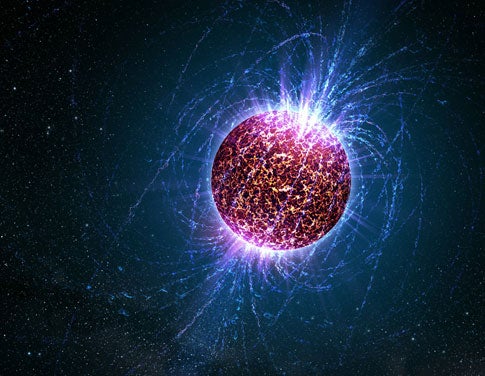U sing NASA’s Swift satellite, McGill University and Penn State University astronomers have identified an object that is possibly the closest neutron star to Earth.
The object, located in the constellation Ursa Minor, is nicknamed ‘Calvera,’ after the villain in the movie “The Magnificent Seven.” If confirmed, it would be only the eighth known isolated neutron star (a neutron star not associated with a supernova remnant, a binary companion, or radio pulsations). “The seven previously known isolated neutron stars are known collectively as ‘The Magnificent Seven’ within the community, and so the name Calvera is a bit of an inside joke on our part,” says co-discoverer Derek Fox of Penn State.
Robert Rutledge of McGill University in Montreal, Quebec, originally called attention to the source. He compared a catalog of 18,000 X-ray sources from the German-American ROSAT satellite, which operated from 1990 to 1999, with catalogs of objects that appear in visible light, infrared light, and radio waves. He realized that the ROSAT source 1RXS J141256.0+792204 did not appear to have a counterpart at any other wavelength.
The group aimed Swift at the object in August 2006. Swift’s X-ray Telescope showed that the source was still there, and emitting about the same amount of X-ray energy as it had during the ROSAT era. The Swift observations enabled the group to pinpoint the object’s position more accurately, and showed that it was not associated with any known object.
“The Swift observation of this source is what got the show going,” says Penn State undergraduate Andrew Shevchuk. “As soon as I saw the data, I knew Calvera was a great neutron-star candidate.”
The team next targeted Calvera with the 8.1-meter Gemini North Telescope in Hawaii. These observations, along with a short observation by NASA’s Chandra X-ray Observatory, showed that the object is not associated with any optical counterpart down to a very faint magnitude. Chandra’s sharper X-ray vision sees the object as point-like, consistent with the neutron-star interpretation.
According to Rutledge, there are no widely accepted alternate theories for objects bright in X-rays and faint in visible light, like Calvera. Exactly which type of neutron star it is, however, remains a mystery. As Rutledge says, “Either Calvera is an unusual example of a known type of neutron star, or it is some new type of neutron star, the first of its kind.”
Calvera’s location, high above the plane of our Milky Way Galaxy, is part of its mystery. In all likelihood, the neutron star is the remnant of a star that lived in our galaxy’s starry disk before exploding as a supernova. In order to reach its current position, it had to wander some distance out of the disk. But exactly how far? “The best guess is that it is still close to its birthplace, and therefore close to Earth,” says Rutledge. If this interpretation is correct, the object is 250 to 1,000 light-years away. This would make Calvera one of the closest known neutron stars — possibly the closest.
“Because it is so bright, and probably close to Earth, it is a promising target for many types of observations,” says Fox. Indeed, to clear up the mysteries surrounding Calvera, the team will be taking a longer observation with Chandra to see if the source pulsates in X-rays, and to measure its spectrum. They also joined a group using a radio telescope to search for radio pulsations, which were not seen.
Calvera could represent the tip of the iceberg for isolated neutron stars. “There could easily be dozens,” says Fox. “The key point is that until our Swift survey, no one was able to refine the X-ray positions of large numbers of ROSAT sources to the point where it became clear which ROSAT sources were ‘missing’ their optical counterparts.”










